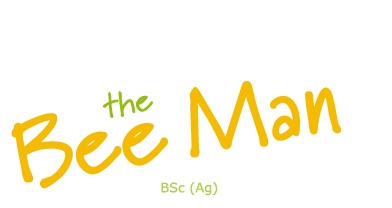| WELCOME FROM BOB THE BEEMAN | Back |
| Wednesday, 20 August 2008 |
Welcome to my revised and renewed website. I hope you find it useful. For you to be reading this you must have an interest in the native bees of Australia. I hope I can, in some small way, advance the cause of these bees, whichever bee they may bee.
My emphasis will be on the stingless bees, the source of sugarbag honey, and part of the traditions of our indigenous peoples for countless generations. As a group, related species have existed around the warm regions of the world for many millions of years. The oldest fossil record from amber comes from the Cretaceous perion, 96-74 million years before the present. This fossil was a worker of Trigona prisca, so the social structure of the hive had developed by this time. They are survivors and evolved to fit many ecological niches around the tropics.
In many countries they have been used for centuries as food, in medicine and religious practices. In Australia, our indigenous people have a high regard for their value as food, and have many traditional uses of hive components. Since they were first encountered after European settlement, they have been regarded of scientific interest to identify, to classify the species, a work still very much in progress. No doubt early settlers realized the value of their sweet stores of honey as they cleared the land for the first time, but when honeybees were introduced to Australia in the 1820’s, the high productivity of this introduced species in a bountiful forested land, relegated the stingless bees to an interesting curiosity. In the 19th century, the term ‘sugar bag’ appeared and has come into general use by aborigines and Europeans alike. Should anyone have information on the origin of this term, and how it came to be applied to the stingless bees, I would very much appreciate hearing from you. Somewhere in the oral or written history of this country must be that information. The stingless bees have attracted the interest of European enthusiasts, and Harold Hockings, for one, reports from the late 19th century of keeping these bees in boxes, of fighting swarms, and subtle differences between species. One of our Trigona species, Trigona hockingsi was named to recognize his work on stingless bees. That tradition of enthusiasts in observing, collecting, keeping and experimenting with colonies has continued to this day in Australia.
I intend to put some of my collection of photographs of bees on this site, and a collection of articles giving downloadable information on various aspects of the stingless bees and other bees.
I have aimed especially to make this material useful to those likely to come across these stingless bees in their work of removing or working with trees, in the hope that in some way the information will help the survival of the compromised colonies. I have many areas of interest as well as the photography, notable researching hive conditions and how logs and various box designs meet those conditions, as well as meeting the management requirements of the meliponist. Resin collection , resin sources and identification of the various species are a very difficult extra field of interest, and progressively information on these will be added to the site.
There is a section of downloadable files so that the reader can download and print the documents. These news updates will highlight topical issues as they occur.
The nearly 2000 other species of bees in Australia will get coverage especially in the photography, and perhaps even some of my overseas experiences. The blue banded bees are the first in this category because of their habit of forming nesting aggregations under Queenslander houses and the concerns that arise form that interaction with people.
It is my intention to write these articles based on my own experience, referring to others where relevant, and inevitably they will reflect my own opinion based on that experience and interpretation. I am always happy to receive input from others who may have more to add, or may have a different experience. There is a contact form on the site to facilitate this.
Thanks for coming to the site. I hope you find sufficient here to keep coming back and contributing if you wish. The native bees of Australia, evolving in a rapidly changing world, will thank you for your interest and concern
Bob the Beeman

